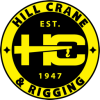 It is necessary that employees involved with hoisting and rigging activities to be trained both in safety and operating procedures. Hoisting equipment must be operated solely by a qualified personnel. Some rigging mishaps are due to lack of knowledge. Training programs provide employees with essential knowledge related to safe hoisting along with rigging procedures.
It is necessary that employees involved with hoisting and rigging activities to be trained both in safety and operating procedures. Hoisting equipment must be operated solely by a qualified personnel. Some rigging mishaps are due to lack of knowledge. Training programs provide employees with essential knowledge related to safe hoisting along with rigging procedures.
Training plus experience help riggers to identify hazards that could have an impact on the hoisting. Riggers must also know the proper assessment and usage of slings and other rigging tools.
Rigging and Hoisting Tips
- Never wrap the wire rope sling fully around a hook. The tight radius could damage the sling
- Make sure that the chain or even body of the hoist must not come in contact with the load
- Never ever point-load a hook except if it is intended and rated for such use
- Don’t wrap the crane hoist rope around the load
- Use a sling or lifting device to rig loads, and also use engineered lift points for attachment
- Avoid bending rope slings near attached fittings or even at eyes sections
- Whenever the hoist is unattended, bring down any attached loads
- Ensure that the load is actually balanced in the hook. Improper loading can reduce capacity dangerously
- As soon as the job is done, put the hoist or hook in an area that will not obstruct workers
- Never work underneath suspended loads or lift up loads above people
The most important safety measure in hoisting and rigging is to identify the maximum capacity of the equipment to be used and the actual weight of the load before lifting it.
Do you have any tips about rigging and hoisting? Feel free to share your thoughts in the comments below!
